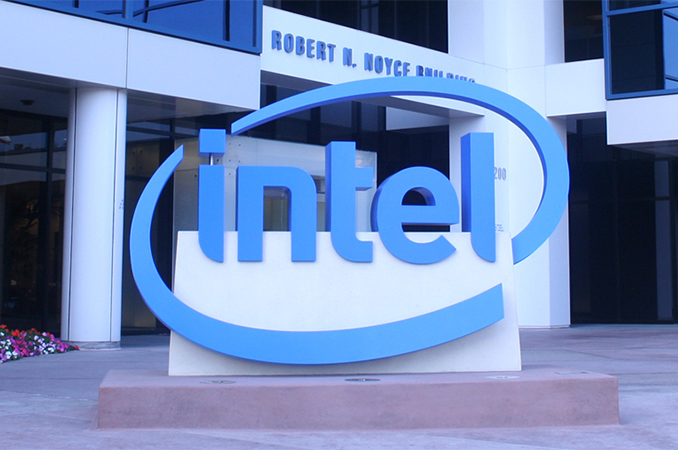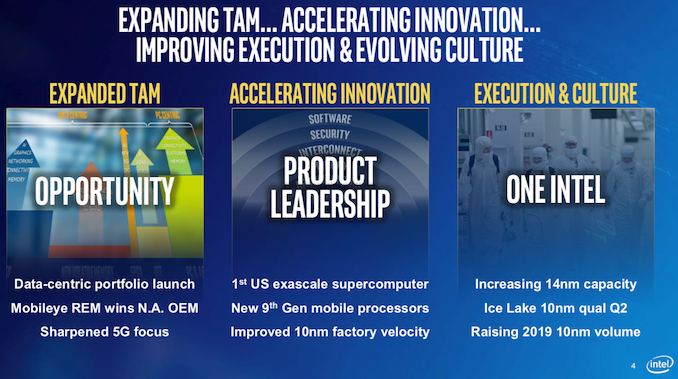Intel Starts Qualification of Ice Lake CPUs, Raises 10nm Volume Expectation for 2019
by Anton Shilov on April 25, 2019 5:14 PM EST
During its Q1 earnings call, Intel provided an update regarding its 10 nm process technology as well as the ramp up of its Ice Lake-U processor for notebooks, which is the company’s first 10 nm design that will be mass produced and broadly available. Qualification for the new processors has already started, so systems based on Ice Lake-U will be available by the holidays, as promised. Furthermore, Intel believes that it will be able to ship more 10 nm parts than it originally anticipated.
Ice Lake-U in 2019
Intel started production of its Ice Lake-U processors in Q1, but Intel has been building up a stockpile of them first before they are sent to PC makers for qualification. Once the CPUs are qualified — something that Intel expects to happen in Q2 — the manufacturer can start sales/shipments of these CPUs, which will likely happen in Q3. Considering the lead-time required to get built systems on to store shelves, Ice Lake-U-based PCs are on track to hit the market in Q4 (something Intel reaffirmed today).
Intel’s Ice Lake-U is a quad-core processor based on the codenamed Sunny Cove microarchitecture. Among other notable features, on the CPU side of matters Ice Lake-U supports VNNI and Cryptographic ISA instructions, as well as Intel's long, long awaited support for LPDDR4X memory. Meanwhile on the GPU side of matters, this is the first chip to integrate Intel’s Gen11 iGPU, which with up to 64 execution units, promises a big step up in performance. The CPU will be paired with a chipset natively supporting Thunderbolt 3, 802.11ax Wi-Fi, and a number of other innovations. The whole Ice Lake-U package is expected to have a TDP of 15 W, so the product will be able to address thin-and-light and mainstream laptops.
10 nm Volume Goals Increased
It is noteworthy that Intel now expects to ship more processors made using its 10 nm process technology than originally anticipated this year as it can produce more these CPUs.
“On the [10 nm] process technology front, our teams executed well in Q1 and our velocity is increasing,” said Bob Swan, CEO of Intel. “We remain on track to have volume client systems on shelves for the holiday selling season. And over the past four months, the organization drove a nearly 2X improvement in the rate at which 10nm products move through our factories.”
Ice-Lake-SP Xeons in 2020
As for 10 nm ramp in general, Intel is only talking about producing its relatively small Ice Lake-U processors in volumes this year, which is the company’s typical way of ramping up a new node. When it comes to their larger Ice Lake-SP server parts, Intel expects to launch those 10 nm Xeon products in 2020. The company says that its Ice Lake-SP CPUs will be available in less than 12 months after its Ice Lake-U products hit the market. In fact, Intel has even advised investors to expect 10 nm Xeons to arrive “rather sooner than later” in 2020, which would imply something earlier than Q4'2020.
Related Reading:
- CES 2019 Quick Bytes: Consumer 10nm is Coming with Intel’s Ice Lake
- Intel 10nm Production Update: Systems on Shelves For Holiday 2019
- Intel Delays Mass Production of 10nm CPUs to 2019
- Intel’s Xeon Scalable Roadmap Leaks: Cooper Lake-SP, Ice Lake-SP Due in 2020
- First 10nm Cannon Lake Laptop Spotted Online: Lenovo Ideapad 330 for $449
- Intel Discloses Plans to Spend $5 Billion on Fab 28 Expansion in Israel
- Intel's 10nm Briefly Appears: Dual Core Cannon Lake in Official Documents
- Intel Mentions 10nm, Briefly
- Intel Displays 10nm Wafer, Commits to 10nm ‘Falcon Mesa’ FPGAs
- Intel: EUV-Enabled 7nm Process Tech is on Track
Source: Intel











70 Comments
View All Comments
Hulk - Thursday, April 25, 2019 - link
Will Ice Lake increase IPC of Coffee Lake?Will power be reduced at the same frequency as a comparably clocked Coffee Lake part?
Or is this the point of 10nm to fit more parts on a wafer and increase profit?
KateH - Thursday, April 25, 2019 - link
that's my question too. There's speculation that Intel's extremely long reliance on their 14nm process may give them an extra bite in the ass in the sense that 14nm parts are SO mature at this point that the new 10nm process won't be much of an improvement power and performance-wise, at least in its initial incarnation.That's just speculation though- and even if there's truth to it, fitting more transistors in a given space is still a boon for yields as you pointed out as well as benefiting extremely large many-core dies by cramming More Cores into less space
saratoga4 - Thursday, April 25, 2019 - link
>Will Ice Lake increase IPC of Coffee Lake?Yes.
>Will power be reduced at the same frequency as a comparably clocked Coffee Lake part?
Yes.
>Or is this the point of 10nm to fit more parts on a wafer and increase profit?
Yes.
Meteor2 - Sunday, April 28, 2019 - link
We won't know the answers until review units arrive, but for the reasons KateH gave the likely answers are no.nevcairiel - Thursday, April 25, 2019 - link
The beauty of a new process node is that it can basically achieve both reduced power and smaller dies, covering 2 of yours already.And for IPC, you should check out the tech preview of Ice Lake/Sunny Cove that was on AT a few months ago.
shompa - Friday, April 26, 2019 - link
but for IPC you usually need more transistors. Adding more cores, for example, takes die size. AVX512 will take a huge part of next-gen Intel. (and Intel loves putting on new instructions so x86 cant is emulated faster on non-x86 parts like 2002 when G5 was released and the fastest windowsPC was a mac with emulation.name99 - Thursday, April 25, 2019 - link
"Will Ice Lake increase IPC of Coffee Lake?"Yes. And it will provide AVX-512.
BUT that's not the interesting question. The interesting question is how MUCH will IPC increase. And that's where the Ice Lake supporters start getting extremely slippery. Every one I've spoken to who insists that this will be Intel's great comeback refuses to even estimate what the IPC increase will be.
"Apple has managed an annual IPC increase of at least 15% since the A7. So will Ice Lake offer at least a 15% IPC increase?" ... crickets...
nandnandnand - Thursday, April 25, 2019 - link
Ice Lake supporters? All I've heard of is Zen 2 supporters. Alternatively, Zen 3.bug77 - Thursday, April 25, 2019 - link
Hm, we're talking 2020 here and no desktop part? Zen2 will have a field day.Irata - Friday, April 26, 2019 - link
If OEM decide to offer good systems with it, then yes.Oh, and also actively market them and not hide them on their own web sites.